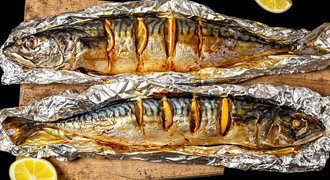Buying
According to NOAA fisheries, the U.S. commercial fishery for Atlantic mackerel operates primarily between January and May in southern New England and Mid-Atlantic coastal waters and between May and December in the Gulf of Maine. This enables a continuous supply of freshly caught seafood year-round.
In the shops, Atlantic mackerel is sold fresh, frozen, in fillets, headed and gutted, and as steaks. You can also find smoked, or salted whole in specialty stores.
If you’re in search of fresh mackerel, look for bright, firm fish with clean skin, pink gills, and clear eyes.
Storage
Due to its high oil content, mackerel spoil quickly unless they are chilled immediately after catching. Those intended for freezing should be promptly chilled after being caught and frozen within a 12-hour window. When properly stored at -30°C in cold storage, frozen mackerel will maintain good quality for a minimum of 6 months.
Proper handling of mackerel is essential to avoid an increased risk of scombroid poisoning if there is a lack of ice or refrigeration.
Preparation
Atlantic mackerel are delicate fish that should be handled properly by keeping them well-iced kept at the lowest possible temperature from the moment of capture until consumption.
Its flesh is soft, flaky, and moist and has a high oil content, and a has a rich, pronounced flavor and fishy taste. It is an excellent substitution for other fish with high oil content such as salmon, tuna, or bluefish.
Because of its high-fat content, mackerel is suitable for grilling, but many recipes call for it to be pan-fried, baked, or broiled. Mackerel complements well with acidic flavorings such as tomato.
Here are some serving ideas:
 |
| Baked mackerel with lemon slices in foil. Photo credit: Marco Verch |
-
Grilled mackerel with lemon and garlic is a delicious recipe.
-
Enjoy flavorful Italian-style smoked mackerel puttanesca pasta.
-
Prepare mouthwatering mackerel patties with canned mackerel, bread crumbs, parmesan, and spices.
Safety profile
Scombroid fish poisoning, also known as histamine fish poisoning, is an allergic-type reaction that occurs after consumption of certain improperly refrigerated fish such as tuna, mackerel, amberjack, and bonito. Since histamines are heat-resistant, cooking spoiled fish will not make it safe to eat.
The most common symptoms are rash, diarrhea, reddening of the face and sometimes the neck, arms, and upper part of the body, sweating, headache, palpitations, and vomiting. Urgent medical attention is needed in severe cases.
The Methyl-mercury content of fresh/frozen skipjack tuna is 0.050 PPM, and hence, categorized as the “Best Choice” fish. FDA advises that one can eat 2 to 3 servings a week from the “Best Choice” list (adult 1 serving = 4 ounces). To compare, King mackerel has 0.73 ppm; categorizing it in the list- “avoid”.
Also read ≺≺-
≻≻-Sardines nutrition facts and health benefits.
≻≻-Atlantic cod nutrition facts and health benefits.
≻≻- Trout fish nutrition facts and health benefits.
≻≻- Dover sole nutrition facts and health benefits.
≻≻- Back to Seafood from Atlantic Mackerel nutrition facts and health advantages.
Further reading (Links opens in new window):
-
NOAA-Fisheries –Scomber scombrus.
-
Omega-3 Fatty Acids: An Essential Contribution.
-
Scombroid fish poisoning: California Department of Public Health.

